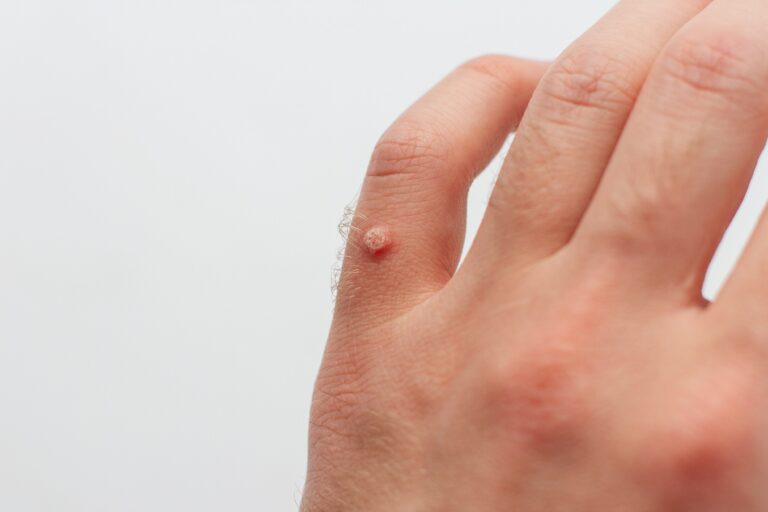Trattamento delle verruche

Warts are small bumps on the skin caused by the papilloma virus. It is more common especially in children and adolescents.
Although generally harmless, they are aesthetically disturbing and sometimes cause complaints such as pain, itching or redness. Warts are divided into two as benign and malignant. Benign ones that occur in mucosal tissues or on the skin are called benign (benign) formations. Malignant warts are referred to as malignant transformation. With wart treatment, benign or malignant warts are removed from the skin surface.
WHAT ARE THE TYPES OF WARTS?
There are many types of HPV that cause warts. Depending on the type of virus responsible for the infection and the region where it is located, morphologically different types of warts appear. There are also some skin lesions that look like warts but have a different origin.
VERRUCA VULGARIS
Verruca vulgaris is the most common type of wart and can be seen all over the body. But it is most commonly found on the hands and feet. It often tends to settle on the fingernails. The size of these warts can reach the size of a pea. Generally, verruca vulgaris causes pressure pain or itching.
VERRUCA FILIFORMIS
It has a long, thread-like body and is a special form of verruca vulgaris type warts. It tends to appear on the face (eyelids, lips, nose) or neck, especially in elderly individuals. These warts can sometimes be itchy. In addition, irritation or injury may occur during washing, drying or shaving. It is quite irritating from a cosmetic point of view and therefore it is recommended to be treated.
VERRUCA PLANTARIS
Warts on the soles of the feet. These warts are quite painful. It is usually transmitted when walking barefoot in public areas such as swimming pools, Turkish baths and gyms. Tapes containing salicylic acid are often preferred for treatment.
POLLINATED WARTS (MOLLUSCA CONTAGIOSA)
Although navel warts look very similar to warts, they are not true warts. It is not caused by papillomaviruses. Unlike true warts, the early microorganism in these wart-like, harmless skin nodules are molluscum contagiosum viruses. Navel warts tend to be located in groups on the body. It is most commonly seen in the genital area in adults. In children, it settles on the trunk, face, neck or armpits.
SEBOREIC WARTS
Seborrheic warts are not true warts. It is not known exactly why they occur. However, it is not caused by viruses and therefore is not contagious. It is usually seen in the elderly and is also called seborrheic keratosis. It is seen on the face, chest, back, back of the hand, arms and legs. They vary in appearance and have different subtypes. It is treated surgically or with a laser.
WHAT ARE WART TREATMENTS?
Electrocautery Treatment (Burning): In the electrocautery method, the lesions are burned by giving sudden heat with high frequency RF waves. Local anesthesia is used to make the procedure painless. The burned areas are crusted and left to the self-healing process. A recovery period of 10-15 days is usually sufficient.
Cryotherapy (Freezing): In cryotherapy treatment, the doctor applies liquid nitrogen to the wart. Liquid nitrogen is extremely cold and destroys the cells in the upper skin layer. Cryotherapy can be performed in different ways. During application, usually a cotton swab is dipped in liquid nitrogen and pressure is applied on the wart for a few seconds. The application should be repeated at least once a week until the wart is completely gone.
Cryotherapy can cause some side effects. With this method, pain during the treatment of warts and a scar or discoloration called scarring may occur on the skin of some people. Warts should not be treated with cryotherapy in people with diabetic foot or peripheral artery disease. Because, for example, treatment applied to warts on the feet can cause nerve damage or poorly healing wounds.
Freezing with liquid nitrogen gas is applied on the wart. There is no open wound, so there is no risk of infection.
Laser Wart Treatment: Laser applications are another treatment option for warts that are resistant to cryotherapy and radio frequency treatments. Special It can be used for resistant warts in areas where the skin is thick, such as the soles of the feet.
Radiofrequency RF Therapy: With this method, which is similar to the electrocautery method, the surrounding tissue is protected from the effect of heat, so healing takes place in a shorter time.
Wart Treatment with Medication: Salicylic acid, trichloro acetic acid can be used.
Surgical treatment: Medication or cryotherapy treatment may not work for some warts. In this case, the wart is treated by surgical removal. After the area is anesthetized with local anesthesia, the wart is removed by cutting with the help of a heated scalpel.